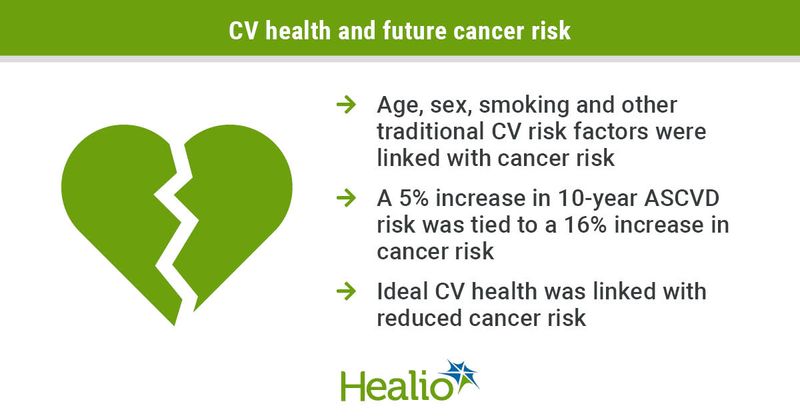Traditional CV risk factors may be tied to future cancer risk
CV risk factors such as age, sex, smoking status, 10-year atherosclerotic CVD risk and certain biomarkers were independently associated with risk for future cancer, according to data published in JACC: CardioOncology.
Researchers found that increases in the American Heart Association’s Life’s Simple 7 CV health score were inversely associated with risk for future cancer.

“Our study leveraged two longitudinal cohorts of subjects who were followed prospectively for incident histologically proven cancer outcomes,” Emily S. Lau, MD, fellow in cardiology at Massachusetts General Hospital, and colleagues wrote. “Within these inception cohorts, we showed that CV risk, as captured by traditional CV risk factors, CV risk scores and biomarkers, was significantly associated with an increased risk of incident cancer. Specifically, traditional CV risk factors, including age, sex and smoking status, were found to be independent predictors of future cancer risk, and estimated 10-year estimated ASCVD risk was associated with future cancer.”
For this analysis, researchers included 20,305 participants (mean age, 50 years; 54% women) in the Framingham Heart and PREVEND studies who had no cancer at baseline to evaluate the relationship between traditional CVD risk factors, CVD biomarkers, preexisting CVD and ideal CV health metrics with the development of future cancer.
Overall, 2,548 incident cancer cases occurred during a median follow-up of 15 years.
CV risk factors and future cancer
Researchers observed that traditional CVD risk factors, including age, sex and smoking status, were all independently associated with incident cancer (P for all < .001).
For every 5% increase in 10-year ASCVD risk, researchers noted an estimated 16% increase in risk for future cancer (HR per 5% increase in ASCVD risk = 1.16; 95% CI, 1.14-1.17; P < .001).
“After removing age and sex, residual ASCVD risk remained associated with future cancer events but modestly,” the researchers wrote. “Our studies were in concert with existing studies that support shared risk factors between CVD and cancer.”
According to the study, the highest tertile of natriuretic peptides compared with the lowest tertile were associated with future cancer (HR = 1.4; 95% CI, 1.03-1.91; P = .035); however, varying levels of high-sensitivity troponin were not (P = .47).
“Although troponins are often elevated in those with prevalent cancer, our data suggest that HF-related pathways rather than atherosclerosis might be the common link between CVD and incident cancer,” the researchers wrote.
Although events such as MI, HF and CVD and the development of interim CV events were not associated with future cancer risk (P for all > .05), researchers found that a 1-point increase in the AHA’s Life’s Simple 7 CV health score was associated with a 5% lower risk for cancer (HR per 1-point increase = 0.95; 95% CI, 0.92-0.99; P = .009).
“These findings provide support for the hypothesis that shared risk factors, rather than CVD itself, contributed to the association between CVD and cancer,” the researchers wrote.
‘The common soil’

“As clinicians, we must break down silos in consideration of preventing CVD and cancer using separate approaches,” Elizabeth A. Hibler, PhD, MPH, assistant professor, and Donald M. Lloyd-Jones, MD, ScM, chair of the department of preventive medicine at Northwestern University Feinberg School of Medicine, wrote in a related editorial. “The common soil of the two diseases (and other chronic diseases of aging, such as lung diseases and degenerative joint diseases, among others) necessitates holistic and comprehensive approaches to communication and implementation of health promotion and disease prevention strategies. Before the onset of either disease, we must use all of our tools in counseling and safe interventions to improve lifestyle and control existing risk factors, with medication use when safe and necessary.
“In this vein, primary CVD prevention is well ahead of the cancer prevention field,” Hibler and Lloyd-Jones wrote. “Moving forward, we must nurture the concept in our patients’ minds of joint benefit to forestall both CVD and cancer, particularly through lifestyle interventions of healthier eating patterns and participation in more physical activity.”

